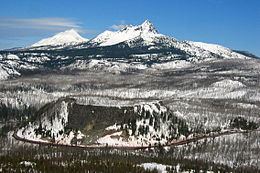Age of rock About 80,000 years Parent range Cascade Range | Mountain type Tuya Easiest route Hiking | |
 | ||
Elevation 5080+ ft (1548+ m) NGVD 29 Similar Hayrick Butte, Hoodoo Butte, Aspen Butte, Yamsay Mountain, Big Hole | ||
Hogg Rock is a tuya volcano in the Cascade Range of northern Oregon, located west of Santiam Pass beside the Santiam Highway (U.S. Route 20 / Oregon Route 126). The highway wraps in a nearly 180-degree curve below cliffs on the south and west sides.
Contents
Map of Hogg Rock, Oregon 97759, USA
Hogg Rock is only about 2 miles (3 km) north of Hayrick Butte, a somewhat larger tuya of similar age and composition. A tuya is a type of subglacial volcano, formed when lava erupts underneath an overlying glacier or ice sheet and then melts through to the surface and pools, producing the flat plateau on top with near-vertical walls along the ice-contact margin as the lava cools and hardens. Unlike most tuyas which have steep cliffs on all sides, Hogg Rock has a break in its cliffs on the east side, with a moderate slope which leads down to a small road and gravel pit.
HistoryEdit
Hogg Rock was named after Colonel T. Egenton Hogg, the promoter of a railroad—Oregon Pacific Railroad—that was supposed to cross the Cascades in this location.
His railroad was based at Corvallis and became known as the Oregon Pacific Railroad (not to be confused with the current railroad of that name). His plan called for a railroad from Yaquina Bay on the Oregon Coast to Idaho via Corvallis and Santiam Pass. By the end of 1884, he completed the rail into Corvallis from the coast and reached Albany by 1886. He then worked up the North Santiam River and completed trackage as far as Idanha before running out of money in 1890. In a final desperate effort to claim the pass for his railroad, he laid rails over Santiam Pass near Hogg Rock and pulled a box car back and forth on them to lay a claim to rail service there in 1890. Hogg went bankrupt and E. H. Harriman of the Southern Pacific Railroad gained control of the line in 1907. The trackage east of Mill City was abandoned when Detroit Dam and Big Cliff Dam were built in 1950, and the dream of a trans-Oregon railroad terminating at Corvallis was gone.
